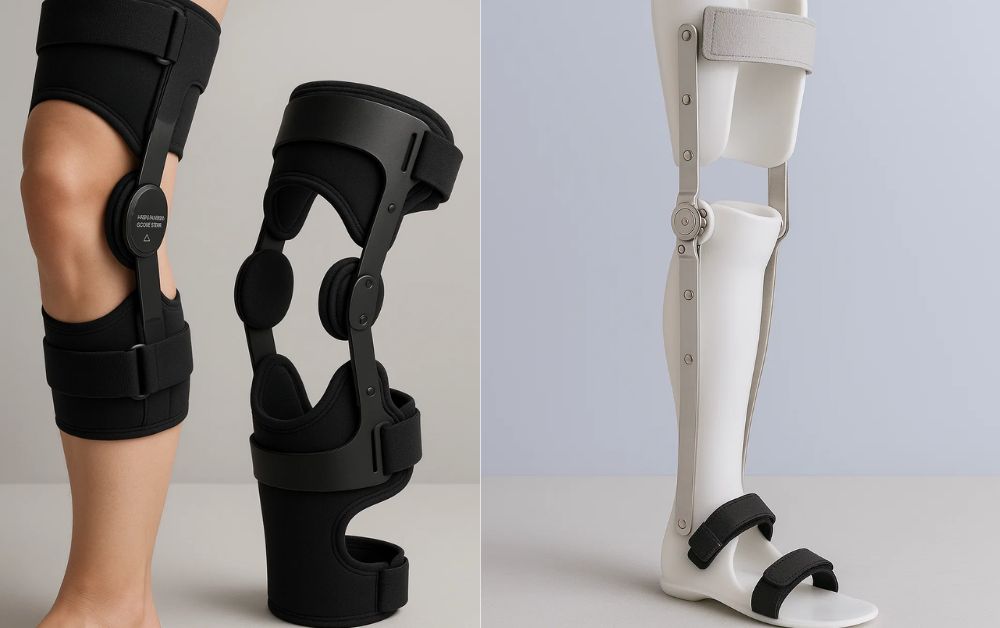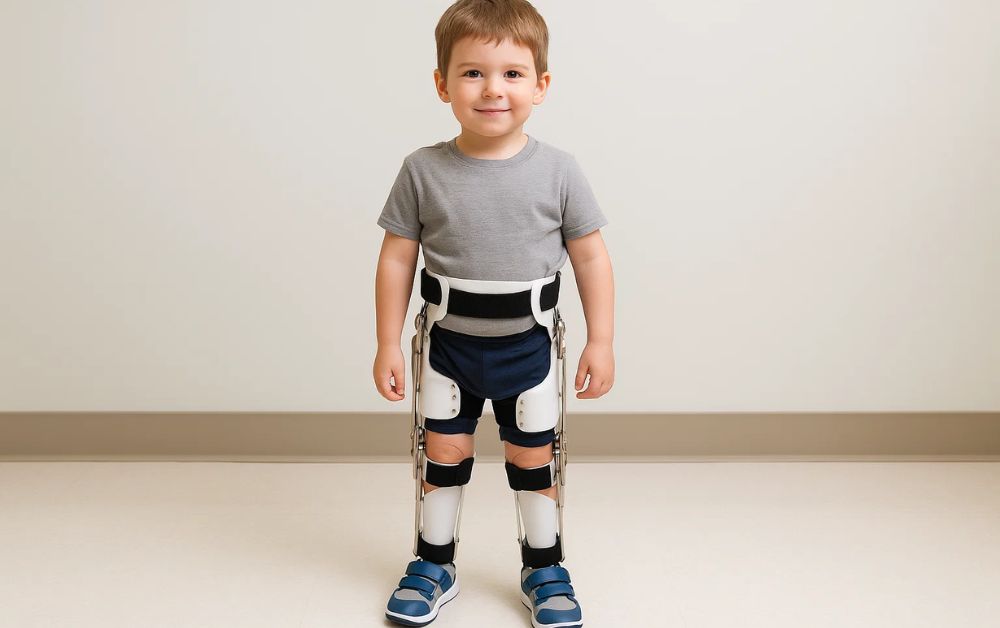What Conditions Require a Hip Knee Ankle Foot Orthosis?
Mobility is essential for independence & quality of life. However, certain conditions can make walking or standing difficult. For individuals with severe weakness or paralysis affecting the hip, knee, ankle, and foot, a specialized device called a Hip Knee Ankle Foot Orthosis (HKAFO) provides the necessary support. In this article, we will explore what an HKAFO is, why it is used, and the medical conditions that require this advanced orthotic solution.

What Is a Hip Knee Ankle Foot Orthosis?
A Hip Knee Ankle Foot Orthosis is a custom-made orthotic device that supports and stabilizes the lower limb and hip joints. It extends from the foot to the hip and is often used for patients who have significant muscle weakness or paralysis in their lower limbs.
Unlike simpler devices such as an AFO (Ankle Foot Orthosis) or KAFO (Knee Ankle Foot Orthosis), the HKAFO provides maximum support, covering all major joints of the lower extremity. It plays a crucial role in allowing patients to stand, walk, or maintain balance safely.
Why Are HKAFOs Important?
HKAFOs are not just braces; they are life-enhancing devices that help individuals regain mobility, improve posture, and reduce the risk of falls. They are particularly useful for people who have lost the ability to control their hips and legs due to neurological or muscular disorders.
Conditions That Require a Hip Knee Ankle Foot Orthosis
Here are the most common medical conditions where a hip knee ankle foot orthosis (HKAFO) Dubai is recommended:
1. Spinal Cord Injuries
Individuals with spinal cord injuries often experience complete or partial paralysis of the lower body. Depending on the level of injury, a patient may require an HKAFO to stand or walk with assistance. This device provides joint stability and supports weight-bearing activities, enabling improved independence and preventing muscle contractures.
2. Polio and Post-Polio Syndrome
Polio survivors often suffer from muscle weakness or paralysis in one or both legs. In severe cases, when both the hip and lower limb joints are affected, HKAFOs provide essential alignment and stability, helping patients walk using crutches or walkers.
3. Cerebral Palsy
Children & adults with severe cerebral palsy may have spasticity or weakness affecting their hips and lower limbs. An HKAFO helps control unwanted movements, improves standing posture, and enhances mobility when combined with physical therapy.
4. Muscular Dystrophy
Muscular dystrophy gradually weakens muscles over time. As the condition progresses, patients may require advanced orthotic support like an HKAFO to compensate for lost muscle function and maintain mobility for as long as possible.
5. Spina Bifida
Children born with spina bifida often have weak or paralyzed lower limbs. An HKAFO is commonly prescribed to aid standing and walking, promoting bone development and preventing joint deformities during growth stages.
6. Severe Lower Limb Paralysis
Any condition that causes paralysis or significant weakness in the hip, knee, & ankle joints may require an HKAFO. This includes traumatic injuries, nerve damage, and some cases of stroke rehabilitation.
Benefits of Using an HKAFO
- Improved Stability: Prevents falls by offering maximum support from hip to foot.
- Enhanced Mobility: Enables standing and walking with assistive devices.
- Correct Posture: Aligns hips, knees, and feet to avoid deformities.
- Prevents Secondary Complications: Reduces risk of joint stiffness, contractures, and bone density loss.
- How Is an HKAFO Fitted?
Getting an HKAFO requires professional evaluation and customization. Here’s the process:
- Assessment: An orthotist evaluates the patient’s condition, range of motion, and walking ability.
- Measurements and Casting: Accurate measurements ensure a perfect fit for comfort and functionality.
- Fabrication: The device is custom-built using lightweight, durable materials for strength and comfort.
- Training: Patients receive training on how to use the HKAFO effectively along with gait training exercises.
Tips for Effective Use of an HKAFO
- Wear recommended footwear for stability.
- Follow the wearing schedule prescribed by your orthotist.
- Regularly inspect the device for wear & tear.
- Pair with physical therapy for best results.

In Conclusion
A hip knee ankle foot orthosis (HKAFO) Dubai is more than just an orthopedic device—it’s a lifeline for individuals struggling with severe lower limb weakness or paralysis. It provides essential support, restores mobility, and enhances quality of life for those living with neurological or muscular conditions.
If you are looking for high-quality custom HKAFO solutions in Dubai, Ortho Innovations L.L.C offers advanced orthotic devices tailored to your needs, ensuring comfort, durability, and maximum support for your mobility.
